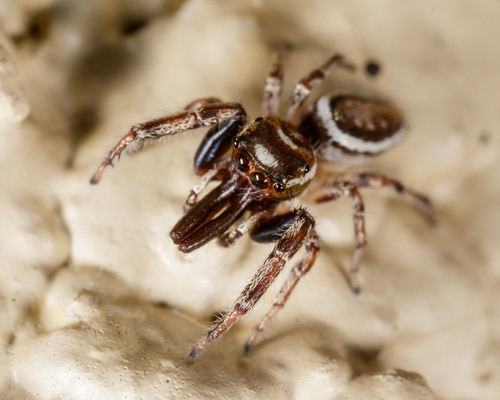
Everything is bigger in Texas, and that goes for the sheer number of spiders that call the Lone Star State home. Spiders are the largest group of arachnids, with over 38,000 species worldwide! 3,000 of those species live in North America, with about half living in Texas.
What are Spiders?

Spiders have eight legs, a cephalothorax (the head and thorax combined), and an abdomen. A shell-like covering protects the cephalothorax, which is called a carapace.
These arachnids have eight eyes, though some species have more or less. A spider’s family can be identified according to its eye placement.
Spiders have two small jaws called chelicerae that end in fangs. The fangs are filled with venom, which they use to paralyze and kill their prey.
They don’t have teeth, making them unable to chew food. Instead, they rub it with their jaws and pedipalps. Pedipalps are the frontal limbs used for holding prey and mating. Then, they turn the edible bits into a goo they can eat.
Beneath their abdomen are spinnerets used to create silk. This silk is used for spinning webs, lining nests, and making tethers and parachutes for when they’re on the move.
Not all spiders spin the familiar spiderwebs, but all spiders make silk. Each species adapted ways to use their silk within their specific environments.
The Most Common Spiders in Texas

Texas’s most common spider families are orb weavers, jumping spiders, and wolf spiders.
These families are beneficial to the environment and don’t pose any threat to humans. They’re perfect to have around, especially if you live in an area with lots of insect pests. In short, spiders are the best, all-natural pest control!
For this article, we’ll focus on these three families and their different webbing habits.
Orb weavers trap their prey in large circular webs. In the garden, they can help you keep pesky, garden-destroying insects at bay.
Jumping spiders pounce on their prey without needing a web to trap them. They’re also excellent at keeping household and yard insects under control.
Wolf spiders are night stalkers. They hunt under the cloak of darkness, preying on creepy crawlies you don’t want in or around your home.
Together, these spider families spell out certain doom for pesky bugs and insects. They’re your free pest control, with no pesticides necessary!
You May Also Like: 25+ Amazing Spiders In Arizona: ID Guide, Pictures, And Facts
Why Spiders Aren’t That Bad

Many people today have an extreme fear of spiders called arachnophobia. This fear often stems from misinformation or bad experiences.
It’s a common belief that spiders will attack and bite unprovoked. Some people also believe all spiders have toxic venom that will harm people and animals. The truth is, spiders want little to do with humans.
Often, we simply lack an understanding of how spiders benefit the ecosystems they live in. In fact, we’re still learning about these elusive creatures until today. Now, it’s your turn to learn!
You may also like: 21 Different Types Of Spiders And Where You’ll Find Them
The 3 Families of Texas Spiders
1. Orb Weavers (Family Araneidae)
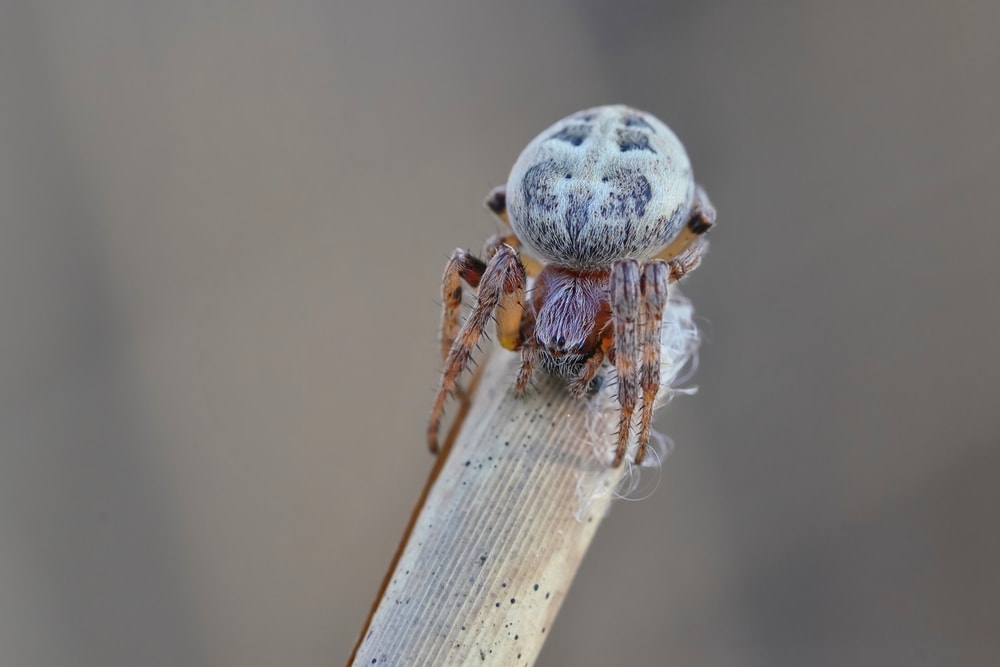
This is one of the largest spider families. In fact, nearly 20 varieties of this family live in Texas.
These spiders spin elaborate, spiraling webs to catch their insect prey. These webs vary in diameter, sometimes reaching nearly 20 feet (6 m).
You can usually find their webs between trees, large objects, or structures. These webs are spun in the early evening for about an hour and then removed each morning. The webbing is often reabsorbed and reused if it isn’t contaminated with dust or debris.
Orb weavers vary widely in size and physical characteristics. They can range from 1/16 to 1 ⅛ inch (2-28 mm) in body length, not including legs.
They come in muted shades of browns and grays to bright hues of yellow and red. Their bodies have typical shapes that can be hairy, spiky, or studded. It’s these varieties that make spiders all the more interesting and fun to search for!
Orb weavers are not known to bite or harm humans. They can bite, of course, if grabbed or squished, but their venom is not medically significant. It’s described as a mild bee sting or sharp poke, which usually doesn’t have any lasting ill effects.
Here are some of the most commonly found orb weavers in Texas.
1.1 Starbellied Orb Weaver (Acanthepeira stellata)

These spiders have brown bodies with star-studded spikes. They are tiny spiders, growing up to under half an inch (12.7 mm). The females are often larger than males.
Though they look quite formidable and tank-like, they’re completely harmless to humans. They also build impressive webs up to 10 inches (25.4 cm) in diameter.
1.2 Giant Lichen Orbweaver (Araneus bicentenarius)

These spiders have light green speckled bodies, red splotches, and big, humped abdomens. They’re relatively large, up to 1.18 inches (3 cm). They create giant, 8-foot (2.4 m) webs in forests and wait patiently at the edge of their webs for prey to arrive.
1.3, 1.4 Tropical Orb Weaver (Eriophora ravilla, Eriophora edax)
These hairy spiders have reddish-brown bodies. Their brown or gray abdomens bear black triangular markings on their underbellies.
Males have smaller abdomens, and some have humps on their backs. Females can be nearly an inch (24 cm) in size, while males are about half that.
They weave massive 19-foot (5.79 m) webs each night and remove them in the morning.
1.5 Humpbacked Orbweaver (Eustala anastera)

This spider has a gray and black patterned body with a distinct hump on its back. They can grow to about 0.3 inches (8 mm), with the males being smaller than females. You can find them weaving their webs in marshy areas and near ponds.
1.6 Butterfly Orbweaver (Araneus pegnia)

These spiders have a brownish-red cephalothorax. They also bear a cream or yellow butterfly-shaped pattern on the abdomen.
Butterfly orb weavers can grow up to 0.2 inches (6 mm). They spin webs in gardens and fields, where flying insects and other spiders are abundant.
1.7 Spinybacked Orbweaver (Gasteracantha cancriformis)

This species is probably the most distinct and crazy-looking species of orb weaver.
It comes in bright colors with six spikes on its abdomen. It can be black and white or black and red, with red spikes dotting its body. It can even be black and yellow spotted with black spikes.
Often called a “crab spider” because of its spiky body, it is not related to actual crab spiders.
This spider can grow up to 0.4 inches (9.5 mm), with males about a third of the size of females. They create their webs in dense tropical foliage and citrus groves.
Their spiky bodies act as protection from predators. No one wants to munch on a spike-covered snack!
1.8 Furrow Spider (Larinioides cornutus)

These relatively large orb weavers can grow up to half an inch (1.27 cm). They’re usually brownish gold with a dark, arrow-shaped pattern on their back. They have a bulbous abdomen with black and brown striped legs. They also build their webs close to the ground in moist areas.
1.9 Orchard Spider (Leucauge venusta)

Being the only spider named by Charles Darwin, this species also spaced aboard Skylab 3 in 1973!
This spider is known for being brightly colored, long-jawed, and long-legged. They have dark stripes on their colorful bodies and red markings on their underbelly. Their skinny legs, shiny bodies, and red markings mistaken them for black widows.
They’re beneficial in the garden to keep nuisance insects at bay. However, they’re also the favorite food of parasitic wasps.
1.10 Silver Garden Spider or Silver Argiope (Argentata argiope)

Garden spiders are a leggier variety of orb weaver and tend to be much larger. The females can grow to 1.3 inches (3.5 cm) with long striped legs.
The species is silver and brown with a lumpy-looking body and black, orange, and yellow stripes.
These spiders spin webs with an X-shaped pattern and heavy zigzags called stabilimenta. These distinct zigzags are the best way to identify this spider. Their webs are also used by tiny dewdrop spiders, who sneak in and steal their prey!
1.11 Black and Yellow Garden Spider (Argiope aurantia)

This is one of the most common spiders found in gardens and parks. They’re black with yellow markings and long banded legs. The females grow to 1.1 inches (2.8 cm), with males being a quarter of her size.
They also weave zigzag patterns into their 2-foot (0.6 m) webs, similar to other garden spiders. They do have venom, like most spiders, but do not bite unless provoked. Their venom was found to have toxins that are beneficial therapeutic medicinal properties.
1.12 Banded Garden Spider (Argiope trifasciata)

Another brilliantly colored and patterned garden spider! This one has pale yellow/silver with bands of black. They have pale legs with dark spots. Females are up to an inch (25 mm), with males being a fifth of her size.
1.13 Arrow-shaped Micrathena (Micrathena sagittata)

This spider has a very distinct arrow shape, hence the name! They have triangular bodies and are brightly colored and spiky. Females are .35 inches (9 mm)with a red cephalothorax, red legs, and a yellow abdomen spotted with black and red. The males are 0.20 inches (5 mm), darker in color, and rarely seen.
1.14 Arabesque Orbweaver (Neoscona arabesca)

These spiders have a distinctive swirling pattern on their abdomens. This characteristic is what gives them their ornamental name. They are usually brown or orange, and females grow to 0.28 inches (7 mm) with the males only slightly smaller. They weave small webs of 18 inches (45 cm) and hide during the day under leaves.
1.15 Hentz’s Orbweaver (Neoscona crucifera)

These spiders are grayish brown and appear very hairy. They grow to 0.75 inches (2cm) and have triangular markings on their abdomen. They make large webs with open centers between trees and shrubs. You can sometimes find them under the overhangs of buildings, too.
1.16 Western Spotted Orbweaver (Neoscona oaxacensis)

This spider has a large black abdomen with cream spots. It also sports a wavy creamy yellow stripe down the length of its body. Its hairy banded legs can grow up to 0.7 inches (18 mm).
They’re primarily found in orchards or grape vineyards, where flying insects are abundant.
1.17 Banana Spider or Golden Silk Spider (Trichonephila clavipes)
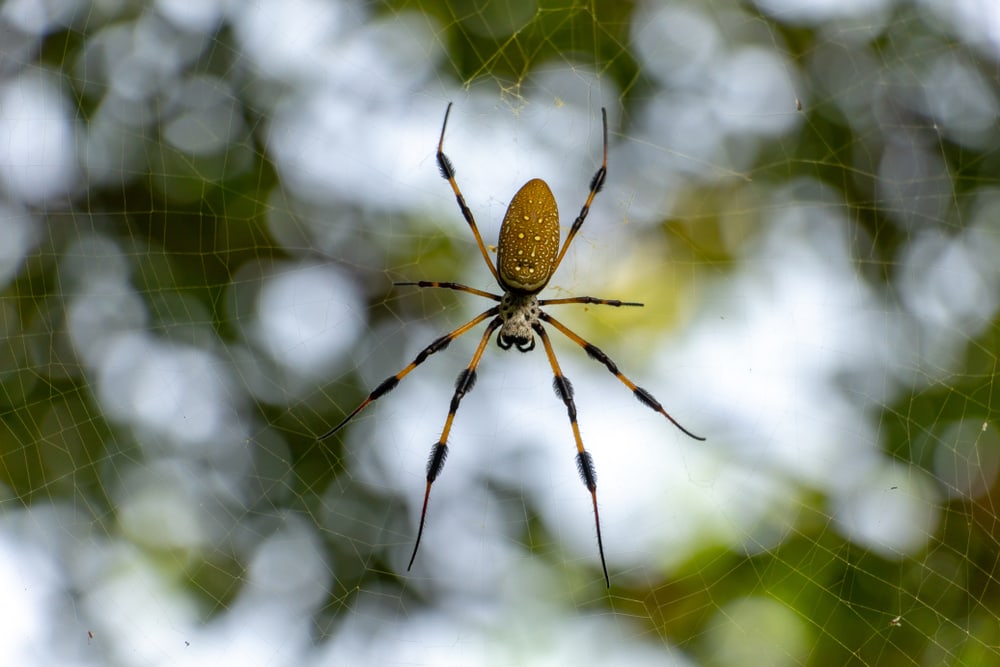
This bright yellow spider has the honor of being one of the largest orb weavers out there. The females grow to 2 inches (5 cm), and the males are tinier, rarely seen at 0.2 inches (0.5 cm).
These spiders build large 6-foot (1.82 m) webs out of golden silk. If that isn’t impressive enough, the silk is also 8 times stronger than steel! It’s so strong, it’s become part of scientific research for medical and tactical purposes.
You may also like: Coyotes In Texas: All About These Masters Of Adaptability
2 . Jumping Spiders (Family Salticidae)

Jumping spiders are possibly the cutest and most animated of all spider families. In fact, the family Salticidae boasts over 6,000 species worldwide! Texas is home to nearly 15 jumping spider species, with more being spotted and identified.
These spiders grow to ⅛ – ⅝ inch (3-15 mm) in body length, so they’re pretty small. They’re known for their leaping abilities and sharp eyesight. They can even leap 40 times their body length!
Can you imagine if humans could do that? Jumping spiders are excellent hunters. They don’t use webs to catch their prey but rely on their keen eyesight and leaping abilities.
They may not spin webs but they still produce silk. When jumping, they use their silk as ropes like a parachute. This neat little trick protects them from falling long distances.
They also make little web nests to hide in, which are called hammocks. These nests defend them from predators and make great nurseries for their young.
Jumping spiders lay egg sacs and reproduce many times after mating once.
The lifespan of a jumping spider is generally 1-2 years. They make great pets as they’re easy to take care of, entertaining, and very social arachnids.
2.1 Twinflagged Jumping Spider (Anasaitis canosa)
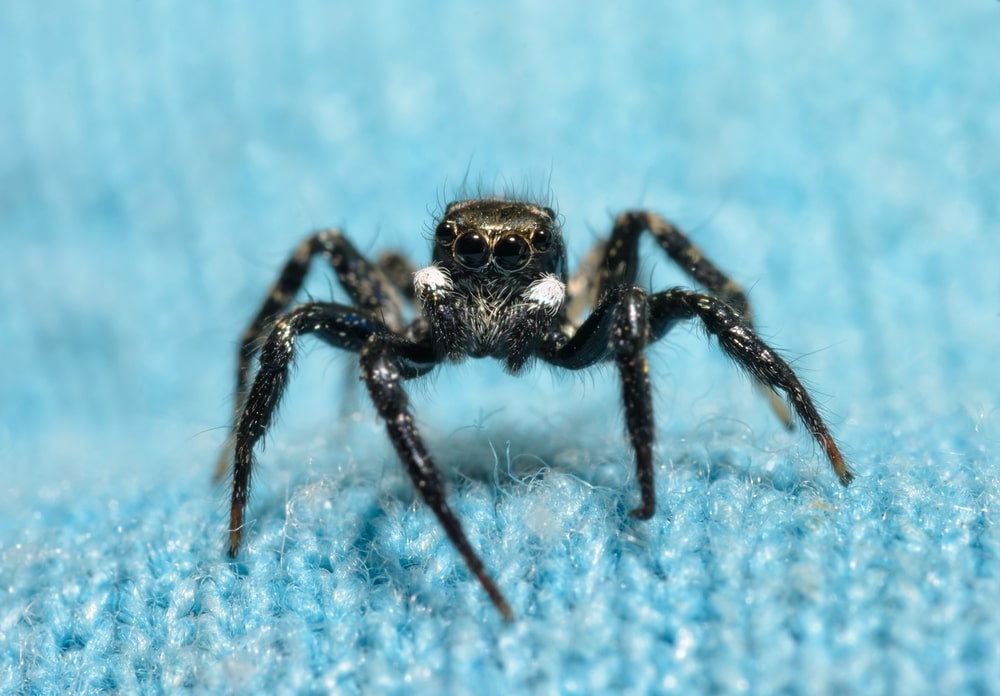
This little cutie is primarily black, with two white spots on its pedipalps. These pedipalps are thought to resemble white flags of surrender.
It only grows to about 0.4 inches (10 mm) and can be found amongst leaf litter or fences, mainly preying on ants. It has a small abdomen that comes to a point with a distinct white dash in the center.
2.2 Bagheera prosper
Unlike many other spiders, this species’ males and females have very different appearances.
The male spider has elongated jaws or chelicerae, which give it a very strange profile. They are mostly brown with white and black markings on the abdomen.
The female is more typical of jumping spiders. They’re more white in color, with brown triangular markings on their back.
2.3 Sylvana Jumping Spider (Colonus sylvanus)

This spider’s big eyes and sleek body give it a threatening appearance. Still, when you find out it’s smaller than a thumbnail, it’s really adorable.
It has a red head, a little cream-colored cap, and a slender greenish body. Its body has cream racing stripes and hairy legs with bands that resemble leg warmers.
There isn’t much else known about these little spiders, as they hide more than they roam.
2.4 Common Hentz Spider (Hentzia palmarum)

These tiny predators only grow to about a quarter of an inch (7 mm). They are brown or black with a crown of coppery red hairs atop their heads.
As highly skilled hunters, they’ve been known to take on prey much larger than themselves.
The males of this species also perform unique courtship dances. To attract a mate, they spread their front legs and arch their backs at a 30-degree angle. Who could resist?
2.5 Magnolia Green Jumper (Lyssomanes viridis)
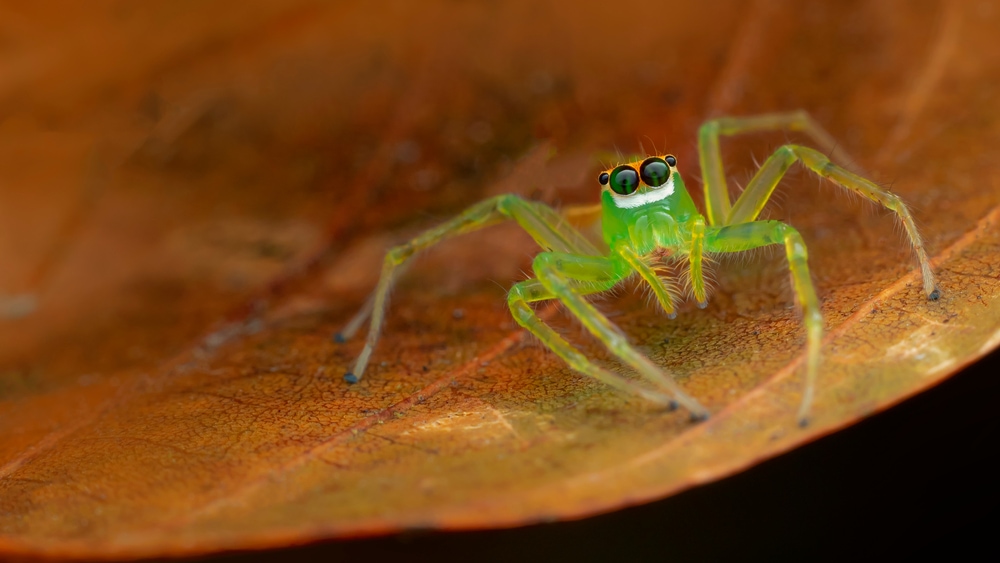
This pale green spider sports black spots along its back and a little hat of red, yellow, white, and orange. Interestingly, their big eyes give the appearance of goggles.
Along with their slender bodies and skinny legs, this species seems almost comical. They’re found in magnolia trees, hiding among leaves and laying camouflaged egg sacs.
2.6 Dimorphic Jumping Spider (Maevia inclemens)
This species’ males have two distinct variations called morphs, where it got its name.
Half of the males are dark morphs with black bodies and white legs. The other half are gray morphs. Gray morphs have gray and white stripes along the body and legs and bright orange pedipalps.
The female has a brown body and legs with red and white markings on her abdomen.
2.7 Gray Wall Jumper (Menemerus bivittatus)

The gray wall jumper is varying shades of gray with black stripes and grayish-white hairs. They can grow up to half an inch (1.27 cm).
As their name implies, they’re often found on the walls of buildings and on tree trunks. They’re known as fierce hunters that can take down prey twice their size.
2.8 Ribbon Jumping Spider (Metacyrba taeniola)

This spider has a dark body with two yellow stripes down its back. They live and hunt under rocks and bark.
They grow to only a quarter of an inch (6 mm) and have enlarged front legs. This spider, though tiny, is larger than the other spiders in its genus.
2.9 Phidippus arizonensis

The genus Phidippus are some of the fluffiest spiders around. The arizonensis is no exception and can grow to nearly an inch (2.5 cm).
The females are brown with dark brown markings on their abdomen and speckled legs. The males are darker than the females, bearing showy orange legs to attract a mate.
2.10 Bold Jumper (Phidippus audax)

The bold jumper is a stunning species, with its black body and triangular white booty patch. They have white markings on their legs and metallic blue or green chelicerae.
These little cuties can grow up to 0.6 inches (1.5 cm) and like to eat prey much larger than themselves. They enjoy eating weevils and moth larvae, which they actively hunt during daylight.
2.11 Cardinal Jumper (Phidippus cardinalis)
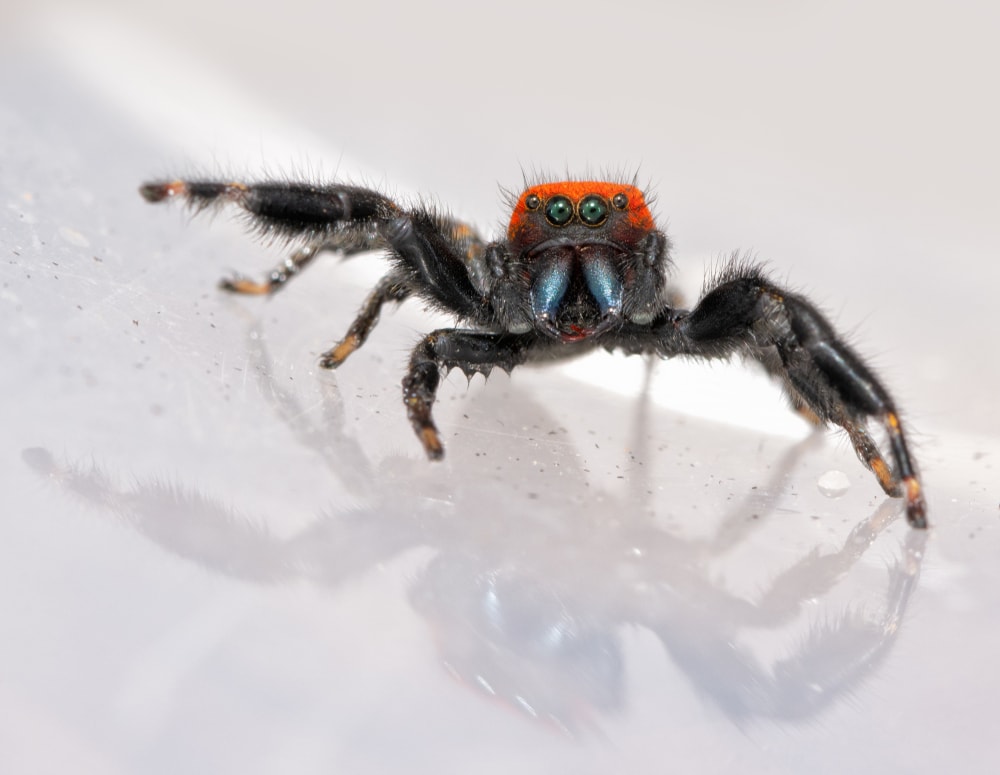
As its name implies, the cardinal jumper has a bold red carapace with black underneath. They live in open grassy areas and eat the unsuspecting insects residing there.
They tend to mimic velvet ants, which they’re often mistaken for. This is because of their red bodies and velvety appearance.
2.12 High Eyelashed Jumping Spider (Phidippus mystaceus)

As you may expect, this species of jumping spider has long hairs upon its eyes. These hairs resemble heavily mascaraed eyelashes or donkey’s ears. They also have dark red hairs below the eyes that look like a mustache.
They are dark gray spiders with black markings and orange and black bands on their legs. They’re considerably tiny, growing to only 0.4 inches (1 cm).
2.13 Tan Jumping Spider (Platycryptus undatus)
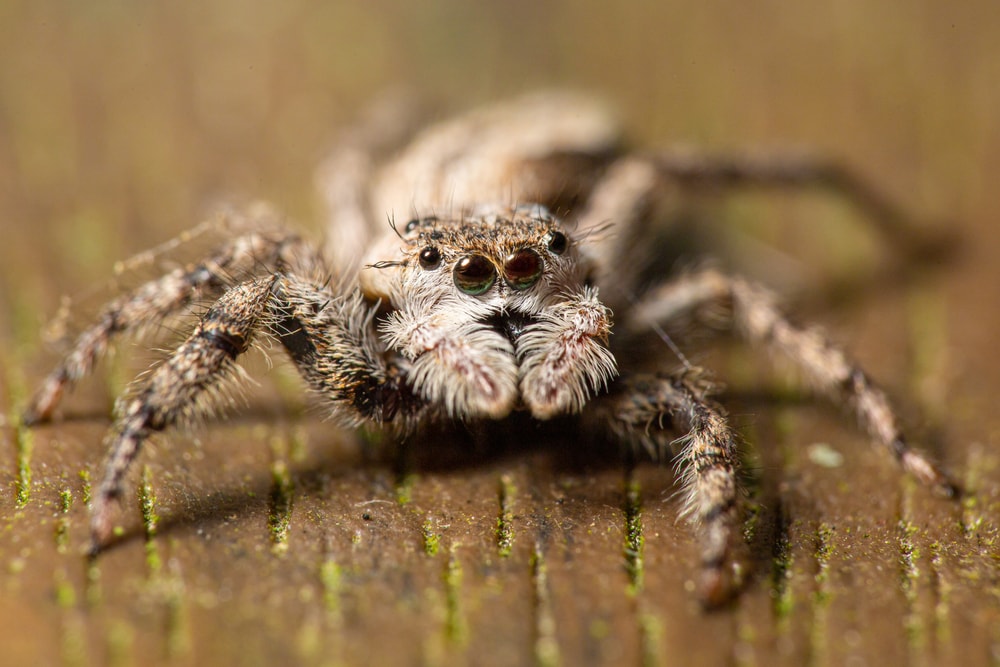
These spiders have brown, tan, or gray bodies with black, white, and red speckles. The markings help them camouflage on mottled surfaces such as tree trunks and bark. They only grow to half an inch (1.27 cm) and eat moths, flies, and smaller spiders.
2.14 Pantropical Jumping Spider (Plexippus paykulli)
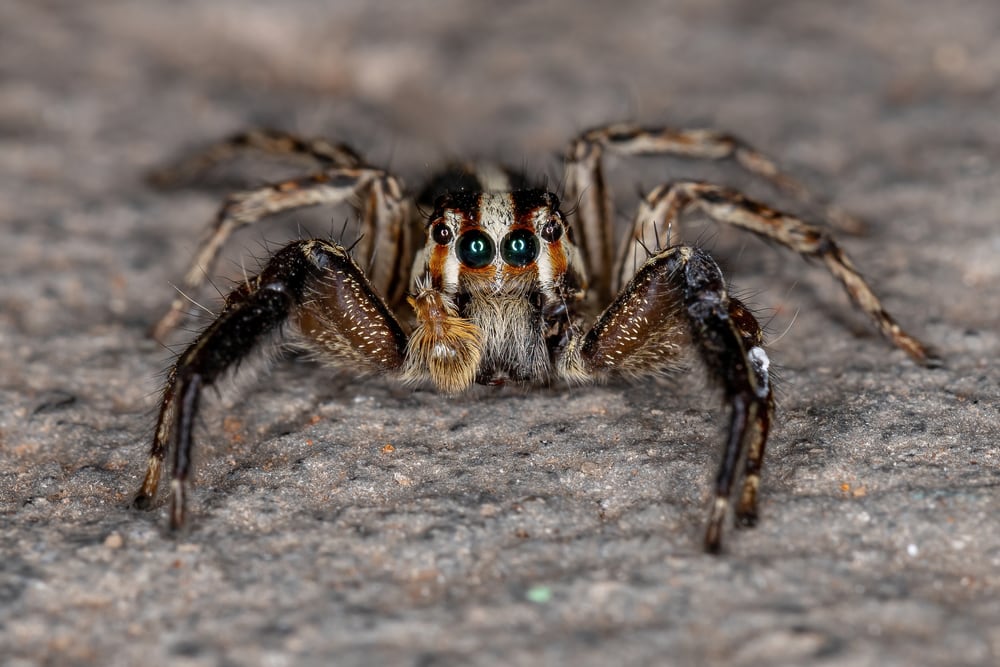
Males of this species sport a black body with a striking white stripe down the center. Females are more muted with subtle brown markings on its body.
They grow up to half an inch (1.27 cm), with the males only being slightly smaller. They hunt their prey by strategically pouncing on it. They can also take different approaches after failed attempts.
You may also like: All The 26 Types Of Texas Turtles (ID Guide And Photos)
3 . Wolf Spiders (Family Lycosidae)

There are over 2,300 species of Wolf Spiders worldwide. Over 200 species reside in the United States, with nearly 15 species calling Texas home.
Wolf spiders are a family of lone night-hunting spiders. Like jumping spiders, wolf spiders also have excellent eyesight. That means they don’t need to rely on webs to catch their prey.
They are generally medium-sized spiders, growing up to 1 ⅜ inches (3.5 cm).
They tend to have furry, dark-colored bodies with mottled patterns. These patterns help them camouflage amongst leaves and tree bark.
You can locate wolf spiders at night by flashlight, as their eyes reflect light. This characteristic is called eyeshine and is common in many nocturnal creatures.
The most unique trait of a wolf spider is how they care for their babies. Unlike most species, wolf spiders don’t keep their eggs in a protected place. Instead, wolf spiders carry their egg sacs with them. It attaches to their spinnerets, and they must rear up their abdomens to keep it from dragging on the ground.
Once the eggs hatch, the mother spider carries all the spiderlings around with her on her back!
The baby spiders stay with her for several weeks. By the time they’re old enough, they can fend for themselves and disperse. Wolf spiders are the only spiders that care for their young in this way.
3.1 Missouri Burrowing Wolf Spider (Geolycosa missouriensis)

This is a species of burrowing wolf spider, meaning this spider makes a burrow or tunnel in which to live in.
Usually found in sandy areas, the spider lines the burrow with silk. This cements the sandy walls and keeps the shelter stable. They spend most of their lives in these burrows, waiting for prey to unknowingly approach.
They grow to be about an inch long (25 mm) and can have an impressive span of legs. The front legs are larger and useful for digging.
They’re varying shades of brown, with dark markings to aid in camouflage. Its cephalothorax sits higher than its abdomen. This is a trait often found in the Geolycosa genus.
3.2 Burrowing Wolf Spider (Geolycosa rafaelana)
Another burrowing wolf spider, this one is darker and more velvety in appearance. They’re black spiders with brown and gold near their chelicerae. They’re medium-sized with an inch (25 mm) long body and long legs.
Geolycosa spiders like to burrow in sandy areas. They’re known to spend most of their lives inside their shelters. They carry their egg sacs and bring them to the shelter’s opening daily to allow the eggs to bask in the sunlight.
3.3 Drumming Sword Wolf Spider (Gladicosa gulosa)

This brown wolf spider spends its life in beech-maple forests. It tends to hide under leaf litter and other ground debris. It does not create any type of burrow or nest and is challenging to spot due to its excellent camouflage.
3.4 Hogna antelucana

The Hogna genus of wolf spiders is one of the largest, boasting over 200 species. These spiders are typically around 1.5 inches (3.8 cm) in body length, with large leg spans.
This genus has two large forward-facing eyes with a row of four smaller eyes underneath and on each side.
They are varying shades of brown. Dark, distinctive bars run down each side of a paler brown stripe on their backs. They’re excellent night hunters and can be found stalking prey in open plains and forests.
3.5 Carolina Wolf Spider (Hogna carolinensis)

The Carolina wolf spider is a mottled black and brown spider. It has silvery hair and a darker underside. They live solitary lives, only coming together to mate in the summer months.
The males sport distinct orange stripes on the sides of their abdomen. Females can grow up to 1.5 inches (3.8 cm), with males being 25 percent smaller.
This species prefers flatter, more open surfaces to hunt their prey and are not great at climbing. They eat insects and other small invertebrates but are also known to munch on small geckos.
3.6 Hogna coloradensis
The Hogna coloradensis can be separated from all other Hogna by a dark area on its underbelly. It also has a small dark area near the spinnerets.
The rest of its abdomen is light brown to tan in color. It bears lighter tanned legs with dark bands. It can be found in sandy areas, where it makes a shallow burrow to hide in during the day.
3.7 Dotted Wolf Spider (Rabidosa punctulata)

The dotted wolf spider is often mistaken for its more common cousin, the rabid wolf. It bears a similar light brown body with stripes down the center. However, the dotted wolf has spots on its underside, which sets it apart from the rabid wolf.
They’re found in tall grasses, cotton fields, and weedy areas. They hunt for crickets, locusts, grasshoppers, and other crop-destroying critters.
3.8 Rabid Wolf Spider (Rabidosa rabida)

The rabid wolf spider isn’t really a “rabid” spider. It’s called that because of its habit of moving fast and in irregular patterns. Their quick and unpredictable movements make them agile hunters.
They’re sometimes confused with dotted wolf spiders. To tell them apart, rabid wolf spiders have more yellow bodies and no spots.
3.9 Field Wolf Spider (Hogna lenta)

As its name implies, the field wolf spider makes its home in fields and grassy areas. It prefers to seek shelter under wood or leaf piles.
They’re brown in color with a light stripe running down the center of their body. They can grow up to about 0.8 inches (2 cm) and are sometimes confused for brown recluse.
3.10 Tigrosa georgicola
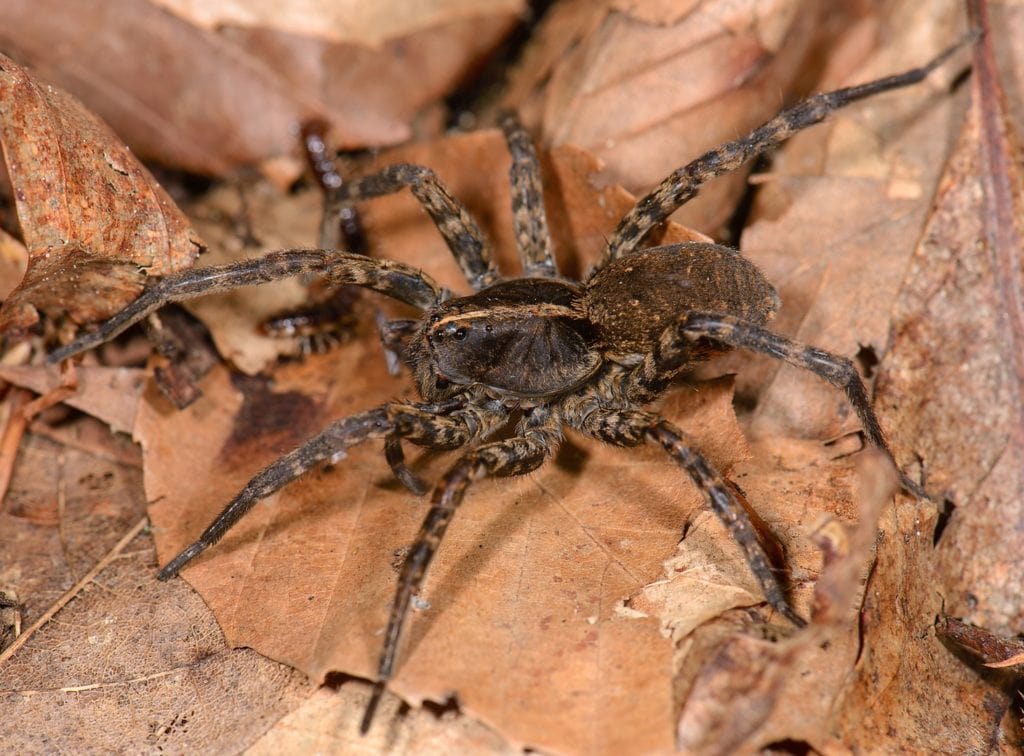
This spider is perfectly adapted to its forest floor habitat. This is due to its dark brown body, prominent markings, and the light stripe top of its body. They grow up to 0.8 inches (2 cm), making their homes under leaf litter and logs.
3.11 Tigrosa grandis

Tigrosa grandis is the second largest species in the genus. In terms of length, they can grow slightly over an inch (2.5 cm).
They boast large, wide bodies that are dark brown to black in color. They also have a lighter band that extends across the entire carapace.
3.12 Tigrosa helluo

Tigrosa helluo have longer, thinner bodies than the grandis and grow to 1.2 inches (3 cm).
They are reddish-brown spiders, with indistinct, muted markings on their back. They’re often found under rocks and logs and prefer wetter areas like marshes and lakes.
3.13 Trochosa sepulchralis

These spiders get their name from the Middle English word “sepulcher”. This term means tomb or burial place. It’s likely this spider was so named because it was first identified in a cemetery.
It has a dark brown body with reddish limbs, which gives off a “goth” vibe. They’re also known to lurk at the edge of wooded areas.
3.14 Varacosa avara

The last species on our list is a smaller spider, growing to about 0.4 inches (1 cm). They have brown bodies, darker brown cephalothorax, and a wide band in the center. They have grayish abdomens and faintly banded legs.
They’re found under stones in meadows and pastures or near the edges of forests. These spiders have also been known to feast on smaller species.





